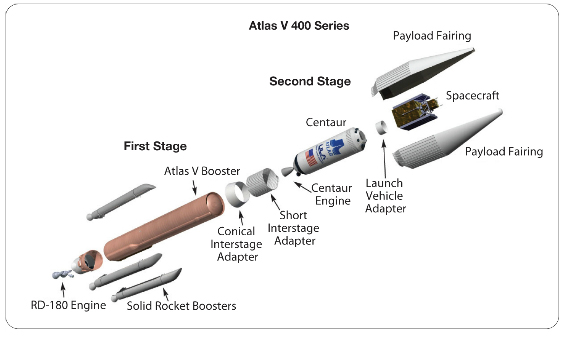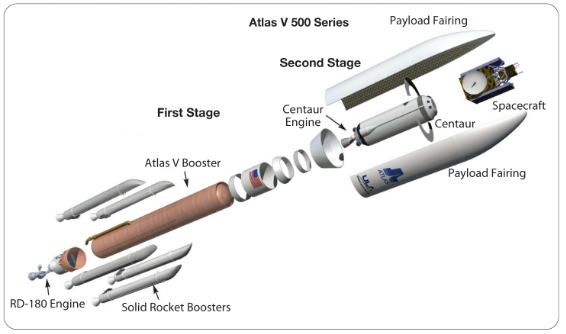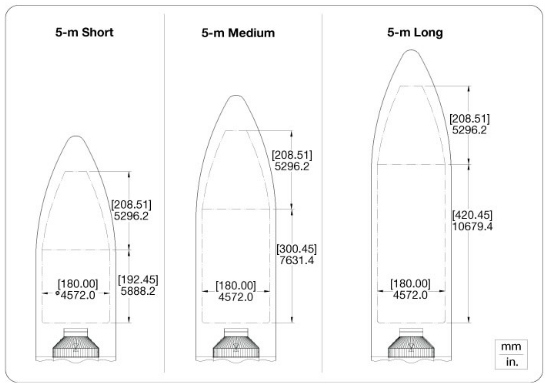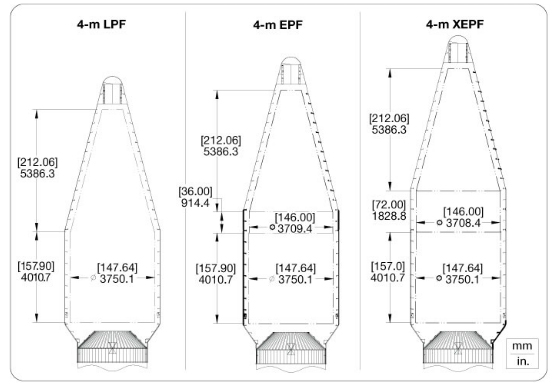Atlas V EELV - Lockheed-Martin
 The Lockheed Martin Atlas V resulted from Lockheed Martin's combination of the best practices from both the Atlas and Titan programs into an evolved commercial and government launch system for the 21st century. Atlas V built on the design innovations demonstrated on Atlas III and incorporated a structurally stable booster propellant tank, enhanced payload fairing options and optional strap-on solid rocket boosters.
The Lockheed Martin Atlas V resulted from Lockheed Martin's combination of the best practices from both the Atlas and Titan programs into an evolved commercial and government launch system for the 21st century. Atlas V built on the design innovations demonstrated on Atlas III and incorporated a structurally stable booster propellant tank, enhanced payload fairing options and optional strap-on solid rocket boosters.
The Atlas V family of Evolved Expendable Launch Vehicles (EELV) represents ULA's commitment to enhanced competitive launch services for the U.S. government. Since their debut in August 2002, Atlas V vehicles have achieved 100 percent mission success in launches from Space Launch Complex-41 at Cape Canaveral Air Force Station, Fla. and Space Launch Complex-3E at Vandenberg Air Force Base, Calif. Built modularly with flight-proven elements, Atlas V has followed a carefully executed program of incremental improvements resulting in 100 percent mission success. Providing customers maximum flexibility, capability and reliability has been the foundation of the Atlas program, which has logged more than 600 launches to date.
The Space and Missile Systems Center (SMC), Launch Systems Enterprise Directorate (LE) Program Office at Los Angeles Air Force Base, CA on 06 November 2017 requested industry feedback on the draft Evolved Expendable Launch Vehicle (EELV) Phase 1A-6 Request for Proposals (RFP), FA8811-18-R-0001 for launch services for five missions (NROL-85, NROL-87, SILENTBARKER, SBIRS GEO-5, and AFSPC-44).
The Air Force released a final Request for Proposal for Evolved Expendable Launch Vehicle (EELV) Launch Services for the following payloads: National Reconnaissance Office Launch (NROL)-85, NROL-87, SILENTBARKER, Space-Based Infrared System Geosynchronous Earth Orbit (SBIRS GEO)-5, and Air Force Space Command (AFSPC)-44. The final RFP was released on Jan. 31 with proposals due back to the Air Force on April 16 in accordance with the solicitation instructions. The contracts for these launch services are expected to be awarded in late 2018.
The Air Force will award firm-fixed-price contracts that will provide the government with a total launch solution for these missions. The award includes launch vehicle production, mission integration, and launch operations. The Air Force’s acquisition strategy for this solicitation achieves a balance between meeting operational needs and lowering launch costs by reintroducing competition for National Security Space missions. This is the sixth competitive launch service solicitation under the current Phase 1A procurement strategy.
“The Air Force utilizes a combination of source-selection techniques from across the best-value continuum that are tailored for each individual mission,” said Lt. Gen. John Thompson, Space and Missile Systems Center commander. “This solicitation incorporates a tradeoff between past performance, performance and schedule sub-factors, and price to maintain a focus on mission success for these critical payloads.”
SBIRS GEO-5 and AFSPC-44 are planned to be launched from Cape Canaveral Air Force Station or Kennedy Space Center in FY 2021. NROL-87 is planned to be launched from Vandenberg Air Force Base in FY 2021. NROL-85 can be launched from the Eastern or Western Range and is planned to be launched in FY 2021. SILENTBARKER is planned to be launched from Cape Canaveral Air Force Station or Kennedy Space Center in FY 2022.
On Feb. 19, 2019 United Launch Services, Centennial, Colorado, was awarded a $441,761,778 firm-fixed-price contract, for launch services to deliver the SILENTBARKER, SBIRS GEO-5, and SBIRS GEO-6 missions to their intended orbits. This launch service contract will include launch vehicle production, mission integration, mission launch operations/spaceflight worthiness, and mission unique activities for SILENTBARKER and SBIRS GEO-5, with an option for an additional SBIRS GEO-6 launch service. The locations of performance are Centennial, Colorado; and Cape Canaveral, Florida. SILENTBARKER is expected to be completed by March 2022, SBIRS GEO-5 is expected to be completed by March 2021. This award is the result of a competitive acquisition and two offers were received. Fiscal 2018 and 2019 space procurement funds in the amount of $308,550,970 will be obligated at the time of award. The Contracting Division, Launch Systems Enterprise Directorate, Space and Missile Systems Center, Los Angeles Air Force Base, El Segundo, California, is the contracting activity (FA8811-19-C-0005).
The benefits of engine reuse have specifically been analyzed with respect to the Atlas V EELV’s RD-180 engine. The cost savings for RD-180 engine reuse is projected to be realized in 2 flights. While previous partial reuse systems were potentially non-cost effective due to g loads where the engine impacted the ground or water, current development of a 3rd generation of mid-air recovery mitigates those g loads. The propellant tanks of the booster are large, fragile, and heavy, and only represent about 1/10 the total cost of booster. Therefore, ULA only intended to retrieve the aft end of the booster.
The engine module with the adjacent Aft Transition Structure (ATS) weighs approximately 25,000 lb – well within demonstrated parafoil recovery capability. It is compact, strongly built, and can be readily severed from the remainder of the booster. After the ATS is separated from the booster tank structure, it will be decelerated with a hypercone in the upper atmosphere. The hypercone provides a moderate deceleration profile to minimize potential damage to the engine. A parafoil with a trailing drogue line and internal GPS system, inflates above the ATS and steers toward the target area for helicopter intercept. A self-guided parafoil that can currently handle the 25,000 lb load is Airborne Systems’ MegaFly parafoil.
The Atlas V family, which includes the flight-proven Atlas V 400 and 500 series, are the latest evolutionary versions of the Atlas launch system. Atlas V uses a standard common core booster™ (CCB), up to five strap-on solid rocket boosters (SRB), an upper-stage Centaur in either the Single-Engine Centaur (SEC) or the Dual-Engine Centaur (DEC) configuration, and one of several payload fairings (PLF). A three-digit (XYZ) naming convention is used for the Atlas V 400 and 500 series.

The Atlas V 400 series incorporates the flight proven 4-m diameter 12.0 m (39.3 ft) large payload fairing (LPF), the 12.9 m (42.3 ft) extended payload fairing (EPF), or the 13.8 m (45.3 ft) extended EPF (XEPF).

The Atlas V 500 series incorporates the flight-proven 5-m diameter 20.7 m (68 ft) short, the 23.5 m (77 ft) medium, or the 26.5 m (87 ft) long payload fairing.

Propulsion
RD-180 Main Engine
Delivering more than 860,000 lbs of thrust at liftoff and an impressive range of continuous throttling capability, the RD-180 main engine is a powerful combination of innovation and performance. Designed and manufactured by NPO Energomash, the liquid oxygen/liquid kerosene, two-thrust-chamber RD-180 engine is a complete propulsion unit equipped with hydraulics for control valve actuation and thrust vector gimbaling, pneumatics for valve actuation and system purging, and a thrust frame to distribute loads.
Nominal Thrust (sea level): 860,300 lbs
Specific Impulse (sea level): 311 seconds
Length: 140 in Weight: 12,081 lbs
Fuel/Oxidizer: Liquid Oxygen/Liquid Kerosene
The predecessor of the Atlas V’s RD-180, the RD-170 was qualified for 10 man-rated flights. As a 2-chamber derivative of the 4-chamber RD-170, the RD-180 uses 70% of the same flight proven components from the RD-1705. The remaining 30% are scaled versions of RD-170 components, and individual parts of the RD-180 have been tested to reusable levels, although full certification of the RD-180 for reuse had never been funded.
Solid Rocket Boosters
When missions demand additional thrust at liftoff, Atlas integrates up to three solid rocket boosters (SRB) on the Atlas V 400 series launch vehicle and up to five SRBs on the Atlas V 500 series vehicles. The Atlas SRB, manufactured by Aerojet, uses the world’s largest monolithic filament-wound carbon composite case.
Peak Vacuum Thrust: 380,000 lbf
Specific Impulse: 279.3 seconds
Length: 787 in
Maximum Diameter: 62.2 in
Weight: 102,950 lbs
Nominal Burn Time: 88.3 seconds
Upper Stage
Both the Atlas and the Delta IV upper stages rely on the RL10 propulsion system to power their second stages. Logging an impressive record of nearly 400 successful flights and nearly 700 firings in space, RL10 engines, manufactured by Pratt & Whitney Rocketdyne, harness the power of high-energy liquid hydrogen and boast a precision control system and restart capability to accurately place critical payloads into orbit.
The Atlas V Centaur upper stage is powered by the RL10A and can be configured with either one or two engines.
Nominal Thrust: 23,300 lbs
Specific Impulse: 450.5 seconds
Fuel/Oxidizer: Liquid Hydrogen/Liquid Oxygen
Length: 91.5 in
Diameter: 46 in
Weight: 367 lbs
Payload Fairings
The PLF is designed to provide a controlled environment for spacecraft.
The Atlas V large payload fairing (LPF), extended payload fairing (EPF), and extended EPF (XEPF) have a common 4-m diameter cylindrical section topped by a conical section. Major sections of these payload fairings are the boattail, the cylindrical section, and the nose cone that is topped by a spherical. The EPF was developed to support launches of larger volume spacecraft by adding a 0.9-m (36-in.) high cylindrical plug to the top of the cylindrical section of the LPF. The XEPF is a modified version of the EPF that incorporates an additional 0.9-m (36-in.) high cylindrical plug to further increase the available payload volume.


The Atlas V 5-m short, medium and long payload fairings were developed along with the increased launch vehicle performance to accommodate evolving spacecraft requirements. The 5-m PLF is a bisector PLF with a composite structure made from sandwich panels with carbon fiber face sheets and a vented aluminum honeycomb core.
All PLFs are configured for off-pad payload encapsulation to enhance payload safety and security, and to minimize on-pad time.
Performance
| 401 | 431 | 551 | |
| GTO | 4,750 kg 10,470 lbs | 7,700 kg 16,970 lbs | 8,900 kg 19,620 lbs |
| LEO-Reference | 9,800 kg 21,600 lbs | 15,260 kg 33,660 lbs | 18,850 kg 41,570 lbs |
GTO (Geosynchronous Transfer Orbit)=35,756 km x 185 km at 27.0 deg LEO-Reference (Low Earth Orbit-Reference) =200 km circular at 28.7 deg
The first four Atlas V were successfully launched on 21 August 2002, 13 May 2003, 17 July 2003, and 17 December 2004 respectively. These launches represented two flights each of two different Atlas V configurations. The Atlas V family uses a single-stage Atlas main engine, the Russian RD-180 and the newly developed Common Core Booster (CCB) with up to five strap-on solid rocket boosters. The CCB is 12.5 ft. (3.8 m) in diameter by 106.6 ft. (32.5m) long and uses 627,105 lbs. (284,453 kg) of liquid oxygen and RP-1 rocket fuel propellants.
The Atlas V-Heavy (Atlas V-H) configuration has been available available 30 months from order. It would use three CCB stages strapped together to provide the capability necessary to lift the heaviest spacecraft.
Additionally, on Atlas V, Lockheed Martin introduced a 4.57-meter usable diameter Contraves payload fairing in addition to retaining the option to use the heritage Atlas payload fairings. The Contraves fairing was a composite design and is based on flight proven hardware. Three configurations would be manufactured to support Atlas V. The short and medium length configurations would be used on the Atlas V 500 series. The long configuration would be used on the Atlas V-H.
The Centaur upper stage uses a pressure stabilized propellant tank design and cryogenic propellants. The Centaur stage for Atlas V was stretched 5.5 ft (1.68 m) and is powered by either one or two Pratt & Whitney RL10A-4-2 engines, each engine developing a thrust of 22,300 lbs. (99.2 kN). Operational and reliability upgrades were enabled with the RL10A-4-2 engine configuration. The inertial navigation unit (INU) located on the Centaur provides guidance and navigation for both Atlas and Centaur, and controls both Atlas and Centaur tank pressures and propellant use. The Centaur engines are capable of multiple in-space starts, making possible insertion into low-earth parking orbit, followed by a coast period and then insertion into GTO. An upgrade to a Fault Tolerant INU is currently in development and will further enhance mission reliability for all Atlas vehicles.
Until recently, ULA had expected to compete for all of the Phase 1A launches with its Atlas V launch vehicle. The Air Force has used the Atlas V since the start of the EELV program, and has experienced high reliability from the launch vehicle. However, the Atlas V main engine, the RD-180, is made in Russia, and the reliance on Russia for this engine became a prominent concern in light of geopolitical events in 2014. The 2015 National Defense Authorization Act included a provision limiting the use by DOD of this engine, and directed DOD to initiate a domestic program to develop an engine that could replace the capability of the RD-180 by 2019.
The act’s language restricting use of the RD-180 has been interpreted in different ways by different parties. According to the Air Force, the current interpretation of the act by the Air Force General Counsel limits ULA’s ability to propose Atlas V for the Phase 1A competitions. ULA has said it would not enter the Delta IV into competition due to that vehicle’s inability to be price competitive.
The need to develop a new US engine had been discussed over the previous decade. The drastic deterioration in US-Russian relations over the conflict in Ukraine has further spurred American politicians’ desire to end dependence on Russian supplies.
Senator John McCain demanded that the US Department of Defense immediately end its cooperation with companies that purchase Russian engines. However, the Committee on Armed Services concluded that the move could threaten U.S. national security.
That is why the ULA was permitted to continue using Russian engines until 2019, when an American replacement is scheduled to be ready. The U.S. will have to spend over $577 billion to develop a new engine. According to a recent piece in Fortune, there are no strong players on the American market at the moment able to create a competitive equivalent.
Russian experts point out that this decision might destroy a whole segment of the market since the RD-180 engine was specifically designed for U.S. rockets. “There is a close link between an engine and a carrier rocket,” said Ivan Moiseyev, head of the Space Policy Institute. “In order to use the RD-180 in Russia or China, it would be necessary to design a launch system that would meet each country’s specific characteristics. So far, there are no projects like that.”
When the United States decided to utilize a foreign engine, RD–180, to boost our rockets into space, it was also agreed that production of that engine would ultimately occur in the United States. For whatever reason, whether it was for economic reasons or inattention, this never occurred.
A massive "must-pass" omnibus spending bill released by Congress on 16 December 2015 would lift the ban on Russian rocket engines being used to launch US military payloads into space. The new bill mandates that competition be open to "all certified providers" of military space launch vehicles "regardless of the country of origin of the rocket engine that will be used on its launch vehicle, in order to ensure robust competition and continued assured access to space."
The legislation also opened the door for the United Launch Alliance (ULA) to re-enter the Pentagon's request for bids to manufacture the rockets that send US satellites into orbit. The ULA is a joint venture of Boeing and Lockheed Martin and has long been the primary contractor for launching US Defense Department payloads, including national security satellites. The firm relies on the Russian-made RD-180 rocket engine, which was banned in the fiscal 2015 defense budget.
In November 2015, the ULA declined to bid for the right to launch a GPS 3 satellite in 2018, leaving Elon Musk's SpaceX company as the sole bidder for the contract. The ULA cited the engine ban among multiple reasons it did not bid.
Some experts, including Senator John McCain, viewed the ULA exit from the competition as an attempt to strongarm the government into lifting the RD-180 ban. McCain pointed out that the 2016 National Defense Authorization Act provided some relief from the ban by permitting the ULA to use nine RD-180s – four more than allowed last year – for upcoming Air Force bids during the transition to non-Russian propulsion systems. However, the ULA said those engines are committed to other missions, and cannot be reassigned on short notice.
On 27 April 2016, US Defense Secretary Ashton Carter laid out a case for the Pentagon to continue purchasing Russian RD-180 rocket engines, arguing that the US has yet to properly test an operational and cost-efficient replacement to the Atlas V, built by US aeronautics vendor United Launch Alliance, and powered by the RD-180. "We can hold our noses, buy RD-180s until that situation is created and fly Atlases with RD-180s," said Carter. “The alternative is to fly our payloads on Delta, which is technically feasible, but much more expensive. And so that is the choice,” Carter said before a Senate Appropriations defense subcommittee. "And we have chosen the choice of going Atlas, recognizing the distasteful fact that it necessitates purchases of up to 18 more RD-180 engines."
The United Launch Alliance (ULA) determined 29 April 2016 that an anomaly with the RD-180’s device regulating the fuel-to-oxidizer ratio entering the rocket’s thrust chamber, or the Mixture Ratio Control Valve (MRCV), was behind the March 22 early shutdown of the Cygnus spacecraft’s booster. "The NPO Energomash created an internal committee to clarify the causes of the engine control system failure. NPO Energomash does not comment on the ULA statement before clarifying all the circumstances," the official told RIA Novosti.
The Atlas V launcher’s first stage RD-180 engine cut off 6 seconds earlier than planned, triggering a longer burn by the Centaur upper stage to compensate for the loss of thrust and velocity. The Atlas V was nonetheless able to carry the Cygnus cargo ship to the required orbit and deliver supplies to the International Space Station.
|
NEWSLETTER
|
| Join the GlobalSecurity.org mailing list |
|
|
|


